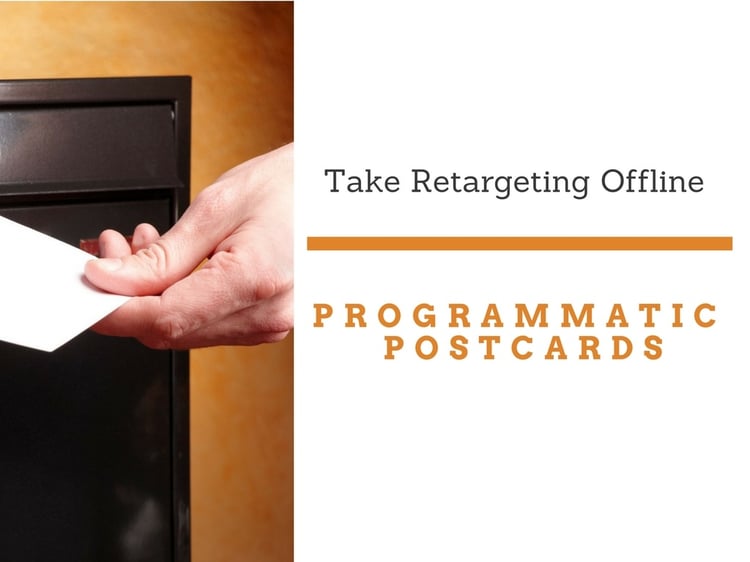I’m sure many of you are aware of the unsuccessful rebranding efforts of JC Penney in 2013. One of the core elements of the rebrand was “everyday low pricing” with the...

Currently, retargeting is thought of as a digital-only proposition. Indeed, banner ads are the most popular form of customer retargeting, but they’re far from the only solution for marketers. In fact, retargeting doesn’t have to be done online at all. Thanks to modern marketing avenues like programmatic postcards, retargeting can reach its full potential as a strategy with high levels of reach and effectiveness.
Learn why E-commerce marketers must rethink the consumer experience and their role in delivering effective marketing at every touchpoint.
Why Retargeting Should Go Offline
Retargeting is a tool that’s easy to use online. But is digital retargeting as effective as it seems?
Digital ad retargeting is helpful because it gives marketers the ability to quickly remind consumers about a product or website they previously checked out. The drawback is that this tactic is used way too often, and instead of leading to a purchase, retargeted banner ads frequently result in customers losing trust in a brand for bombarding them with ads they don’t want to see on every website they visit. Additionally, the widespread popularity of ad blocking software makes it less likely that consumers will see even the best and most well-intentioned retargeting ads.
Clearly, the idea of retargeting is an important one, even if the execution is less than perfect. After all, who wouldn’t want to reach out to people who have shown recent interest in your products? But there are ways to retarget customers without leaving yourself at the mercy of ad blockers and spam filters. Programmatic postcards provide an impactful touchpoint while simultaneously increasing your chances of receiving a favorable response from your customer base.
According to Wishpond, the average response rate for a retargeted banner ad is 0.7 percent. While this rate is significantly higher than that of regular display ads, the truth is that this figure doesn’t come close to the effectiveness of direct mail. Direct marketing response rates for prospect lists were 2.9 percent in 2016, a rate four times higher than that of retargeted display ads. What’s more, direct mail has a return on investment of 122 percent, while online display ads clock in at just an 18 percent ROI. The power of direct mail is clear, but how it relates to retargeting might not be as obvious.
Contrary to popular belief, direct mail doesn’t have to be a totally offline venture. In fact, the insights derived from digital marketing can be efficiently applied to direct mail. It’s this information that’s obtained digitally that will help you to identify the best prospects for your offline retargeting efforts, drastically increasing your response rates and boosting your sales numbers.
Retargeting with Digital vs. Emails vs. Postcards
At the end of the day, there’s no truly bad channel in which to employ retargeting, although poor execution online remains a real problem. Each method has its strengths and weaknesses, and some are more effective than others, especially among various segments of the marketplace. But there’s no rule that says you have to use only one medium for retargeting.
The common use of digital display retargeting ads is so prevalent because it’s quick and immediate. You can remind consumers about your products long after they visit your website, and you can do so in a minimally invasive way if you use individualized and personalized marketing effectively. However, using this technique means you may risk alienating the consumer, and your message may not be seen at all if that individual is using an ad blocker. Furthermore, the limited space available in a banner ad means you have limited options for customization, making it hard for you to truly appeal to the individual customer.
Email retargeting is more of a one-on-one conversation with a potential customer, so it gives you the chance to do something different than your typical banner ad allows you to do. You can apply your internal data towards making the perfect pitch to the consumer, and you can do so in a programmatic manner. This can be done with virtually the same speed as display ads, and with a higher response rate. Unfortunately, email marketing runs into some of the same pratfalls as display ads. People may receive hundreds of emails a day, and they may merely glaze over yours, if they even read it at all. Additionally, as we saw with banner ads, excessive emailing may result in a formerly interested consumer unsubscribing and ignoring your company.
Using programmatic postcards provides the most incisive method of retargeting. A postcard competes with much less real estate than a banner ad or an email, making it more likely that your message will be received and considered. This unique approach, combined with the high-response nature of direct mail, gives you a great way to reach out to a consumer. To make this approach truly effective, you must partner with a vendor who can help you identify and match unidentified website visitors to postal addresses, or else you’ll only be able to retarget consumers who are already in your database.
What’s the ideal retargeting solution? The answer isn’t which one is best for you; instead, it’s the one that works best for the consumer. Much like marketing as a whole, there’s a place for all three of these methods. The real solution depends on the individual consumer — what they like, what they’ve responded to in the past and where they reside on the buyer’s journey.
Although the type of retargeting you use for each unique customer may be up to the individual, there’s still plenty you have to do on your end. Your retargeting is only as good as your infrastructure for tracking consumers, identifying trends and spotting retargeting opportunities. Without addressing these factors, no retargeting strategy will be able to help you.
Getting Postcard Retargeting Right
Although programmatic marketing is becoming more and more popular all the time — and programmatic marketing is predicted to double by 2018 — many marketers are setting themselves up for failure, because they are limiting their programmatic outreach to a few tried-and-true channels without exploring the potential of taking programmatic into new areas, like direct mail or TV or even the IoT (Internet of Things). The results of trying new retargeting methods will depend largely on the data you can collect on a consumer and your organization’s ability to quickly execute when a marketing opportunity arises.
Retargeting without specific goals is a fruitless exercise. And because the initial cost of programmatic postcards may seem higher than a banner ad or an email, it’s in your best interest to get your strategy straight before you send postcards to people who aren’t ready to act upon them. Here are three situations where the distribution of a programmatic postcard can be highly beneficial for both the company and the individual receiving the postcard.
- Email Un-Subscribers: An email list that provides relevant information and value to the consumer is a great way to encourage repeat business, but consumers who have unsubscribed from your email list — but continue to visit and/or purchase from your site — are still worth marketing to. An individualized postcard can help them remain in a conversation with your brand in a way they prefer, and the tangible nature of the postcard results in a more effective reminder than a banner ad.
- Abandon Carters: Customers who abandon items in their shopping carts or don’t finish filling out a form on your website are on the cusp of entering into a deeper relationship with you. They’ve already shown they’re interested. Don’t let them seek out the competition — use a postcard to show just how much you value your relationship with these individuals.
- Engaged Website Visitors: Through intent data you can see which website visitors are on the verge of making a purchase. Those who are at the bottom of their purchase funnel would receive the most benefit from retargeting. Reach out to these consumers with programmatic postcards and provide them with enough incentive to seal the deal.
There are many other scenarios in which programmatic postcards can help you retarget consumers at the appropriate time. Fully understanding your buyer’s journey will help you to identify the best scenarios for issuing postcards. The more you know about your audience and the individual consumer and their path to purchase, the better equipped you’ll be when it comes to furthering the conversation with valuable marketing messages. Today’s customer doesn’t want a plain vanilla marketing campaign — they want to know that they’re valued, and they want to feel understood on an individual level. Programmatic postcards can go a long way towards presenting your company as more caring and understanding than the competition.
Retargeting with Programmatic Postcards
Although retargeting has lived mostly in the realm of digital marketing, it doesn’t have to stay that way forever. Modern products like programmatic postcards can leverage the online data collection you’ve already done and utilize that information in an offline manner, turning annoying banner ads into far-reaching personalized pitches. Using programmatic postcards when appropriate can send your retargeting efforts into the stratosphere, furthering relationships and increasing your marketing ROI.

